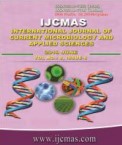


 National Academy of Agricultural Sciences (NAAS)
National Academy of Agricultural Sciences (NAAS)

|
PRINT ISSN : 2319-7692
Online ISSN : 2319-7706 Issues : 12 per year Publisher : Excellent Publishers Email : editorijcmas@gmail.com / submit@ijcmas.com Editor-in-chief: Dr.M.Prakash Index Copernicus ICV 2018: 95.39 NAAS RATING 2020: 5.38 |
Pearl millet crop suffers from many fungal diseases, among them blast caused by Pyricularia grisea (Cooke) Sacc, is one of the important diseases in recent years. Hence with a view to generate information on management of disease using chemicals and bio agents. In vitro evaluation of twelve fungicides and six bioagents were carried out against Pyricularia grisea causing blast of pearl millet. Among the systemic fungicides evaluated, Tricyclazole 75% EC inhibited 100 per cent mycelial growth of the pathogen, followed by Carbendazim 50% WP (99.50%) and least inhibition was observed in Azoxystrobin 23% SC (19.13%). Among the contact fungicides, Mancozeb 75% WP inhibited 100 per cent mycelial growth of the pathogen followed by Copper oxychloride 50% WP (83.57%) and least inhibition was observed in Zineb 75% WP (38.86%). Among combi fungicides, Carbendazim 12% + Mancozeb 63% (SAAF) inhibited 100 per cent mycelial growth of the pathogen, followed by MERGER (Tricyclazole 18% + Mancozeb 62% WP) 98.64 per cent, and AVTAR (Hexaconazole 4% + Zineb 68% WP) 97.40 per cent. Among the bioagents Trichoderma harzianum (Tri 5) and Pseudomonas fluorescens (RP-46) gave maximum per cent inhibition of 77.03 and 67.77 respectively. Hence these fungicides and bioagents could be utilised as most important components for the management of blast of pearl millet under field condition.
 |
 |
 |
 |
 |